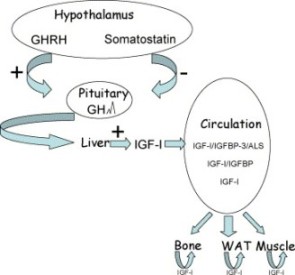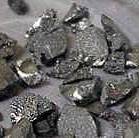We now know that PSA (prostate specific antigen) is a serine protease produced by both prostate epithelial cells and prostate cancer. The serine proteases are a family of enzymes that cut certain peptide bonds in other proteins. Thus, PSA has enzymatic ability to degrade extracellular matrix (structural support) proteins such as fibronectin and laminin. This action of PSA may promote tumor growth, invasion and metastasis of prostate cancer.
 Another potential tumor-promoting action of PSA involves freeing insulin-like growth factor 1 (IGF-1) from its binding protein (BP-3), providing increased local levels of IGF-1 and leading to tumor growth. IGF-1, generally secreted by the liver as a result of stimulation by growth hormone (GH), is important in both the regulation of normal physiology and a number of pathological states such as cancer. Circulating IGF-1 levels are positively associated with increased risk of prostate cancer.
Another potential tumor-promoting action of PSA involves freeing insulin-like growth factor 1 (IGF-1) from its binding protein (BP-3), providing increased local levels of IGF-1 and leading to tumor growth. IGF-1, generally secreted by the liver as a result of stimulation by growth hormone (GH), is important in both the regulation of normal physiology and a number of pathological states such as cancer. Circulating IGF-1 levels are positively associated with increased risk of prostate cancer.
Activation of IGF-1 receptor (IGF-1R) by IGF-1 has mitogenic and anti-apoptotic effects on normal and malignant prostate cells. IGF-1R transmits information provided by extracellular stimuli into intracellular pathways resulting in the subsequent regulation of various effector systems. Under normal cellular conditions IGF-1R signaling network is tightly regulated. IGF-1R is overexpressed in many tumors. Thus, IGF-1/IGF-1R action appears to be important for prostate cancer initiation and progression.
A reduction in PSA’s enzymatic activity should decrease the amount of IGF-1. This in turn should decrease prostate cancer growth. Boric acid is a known inhibitor of several serine proteases. Studies have shown that boric acid and boronic acid significantly inhibit the degradation of fibronectin by enzymatically active PSA. Blood boric acid levels as low as 8 mcg/ml can inhibit the proteolytic activity of PSA. Boric acid administration should therefore reduce circulating IGF-1 level. Reduced IGF-1R signaling should be accompanied by decreased IGF-1 and decreased tumor growth.
Boron is a vital trace mineral that can be found in most soil types as well as in fresh and salt water, consequently, boron is a natural constituent in the human diet. Boric acid is the most common form of boron. Due to their content of boron, boric acid and borax (sodium borate) have basically the same health effects. The boron content of Borax is 11.3% while for boric acid it is 16.5% or about 40% higher. Boron is efficiently absorbed and excreted in the urine.
In response to both low and high dose boric acid solution (1.7, 9.0 mgB/kg/day) supplementation, serum PSA levels decreased by 88.6% and 86.4%, respectively, as compared to the control group, while tumor size declined by 38% and 25%, respectively. Also noted was a significantly lower incidence of mitotic figures in the boron-supplemented groups. Mitotic figures reflect DNA synthesis and proliferative activity. Consistent with these findings, recent study showed that boron inhibited the proliferation of prostate cancer cell lines DU-145 (an androgen-independent line) and LNCaP (an androgen-dependent cell line) in a dose-dependent manner. These animal and cell line studies appear to be relevant to humans.
Insulin-Like Growth Factor (IGF) family and prostate cancer.
Implications of insulin-like growth factor-I for prostate cancer therapies.
IGFBP-3 is a metastasis suppression gene in prostate cancer.
Receptor activated Ca(2+) release is inhibited by boric acid in prostate cancer cells.
Boric acid inhibits stored Ca2+ release in DU-145 prostate cancer cells.
Cellular changes in boric acid-treated DU-145 prostate cancer cells.
Boric acid inhibits human prostate cancer cell proliferation.
 Cancer commonly starts with the deterioration of cell membranes. As boron is essential for cell membranes and boron deficiency widespread, this may be an important cause for the initiation of tumour growth. An adequate amount of boron in the soil is 12 mg/kg. If the boron content of the soil drops below 0.14 mg/kg then boron deficiency is likely to be observed. Boron deficiency is also observed in basic soils with a high pH because in basic conditions boric acid exists in an undissociated form which the plant is unable to absorb. Soils with low organic matter content (<1.5%) are also susceptible to boron deficiency. Highly leached sandy soils are also characteristic of boron deficiency because the boron will not be retained in the soil
Cancer commonly starts with the deterioration of cell membranes. As boron is essential for cell membranes and boron deficiency widespread, this may be an important cause for the initiation of tumour growth. An adequate amount of boron in the soil is 12 mg/kg. If the boron content of the soil drops below 0.14 mg/kg then boron deficiency is likely to be observed. Boron deficiency is also observed in basic soils with a high pH because in basic conditions boric acid exists in an undissociated form which the plant is unable to absorb. Soils with low organic matter content (<1.5%) are also susceptible to boron deficiency. Highly leached sandy soils are also characteristic of boron deficiency because the boron will not be retained in the soil
Plants absorb boron from the ground and through plant-consuming animals it can end up in food chains. The primary role of boron is its involvement in the stabilization of the primary cell walls in plant cells. Diets with a fair amount of fruits (non-citrus fruits such as plums, red grapes, apples, pears and avocados) and vegetables provide about 2 to 5 mg of boron per day, but this also depends on the region where the food was grown and how it was grown. In a typical adult daily intakes of boron were measured to be approximately 1 mg/day.
Boron is required for normal growth and health of the body. Many disease conditions like arthritis, menopausal symptoms and osteoporosis among others are naturally managed by Boron. It is believed that boron improves the natural ability of human body to absorb calcium and magnesium. Boron deficiency causes greatly increased amounts of calcium and magnesium to be lost with the urine. A boron supplement will reduce the daily loss of calcium by nearly 50%. It also has a role in converting vitamin D to its active form, thus increasing calcium uptake and deposition into bone and teeth rather than causing soft tissue to calcify.
In addition, Boron also appears to be involved in the metabolism of hormones. In particular, it raises testosterone levels in men and helps to build muscle. Boron also helps to regulate estrogen levels because by helping to convert vitamin D to its active form. Much of the recent research on boron’s anti-carcinogenic potential has been particularly centered on prostate cancer. Also other beneficial effects have been reported such as improvement of heart problems, vision, psoriasis, balance, memory and cognition.
Resent studies have revealed that phenylboronic acid (PBA) is a more potent and selective inhibitor of cancer cell migration and viability than its parent compound, boric acid. The ability of PBA to elicit a selective anti-migratory response short term, while decreasing cancer cell viability long term, makes it a promising candidate for a novel anti-cancer treatment.
PBA is a boronic acid containing a phenyl substituent and two hydroxyl groups attached to boron. PBA is white powder and is commonly used in organic synthesis. PBA is used in biology schemes as receptors and sensors for carbohydrates, antimicrobial agents and enzyme inhibitors, neutron capture therapy for cancer, transmembrane transport, and bioconjugation and labeling of proteins and cell surface. ProatsZym contains both boron (as boron citrate/aspartate/glycinate complex) and phenylboronic acid.
Boron therapeutics on the horizon.
A lignan is a phytoestrogen (estrogen-like chemical compound present in plants) found in the hulls of flax seed. Lignans are also found in rye and barley, seeds, and fresh fruits and vegetables but flax seed has the highest concentration of lignans found in any natural food source. The main lignan in flax seed is SDG (secoisolariciresinal diglucoside). When eaten SDG is converted in the body to enterolactone and enterodial by the action of intestinal bacteria. Enterolactone inhibits IGF-1-induced activation of IGF-1R and suppresses proliferation and migration of prostate cancer. Isoflavon genistein was also shown to inhibit IGF-1-induced activation of IGF-1R. ProstaZym is the purest, most highly bioavailable source of enterolactone and genistein.